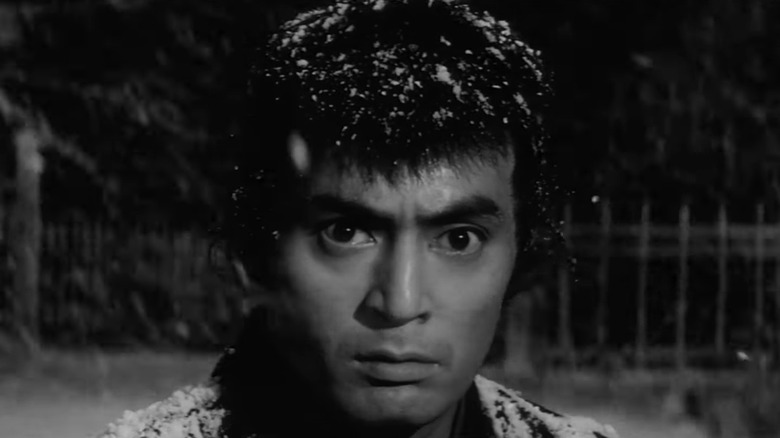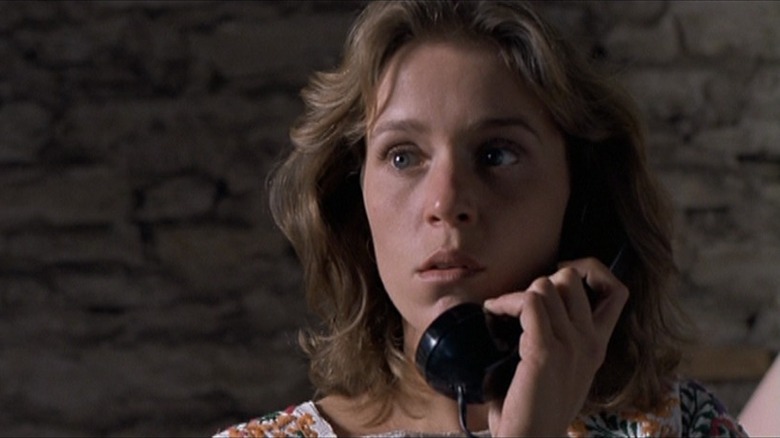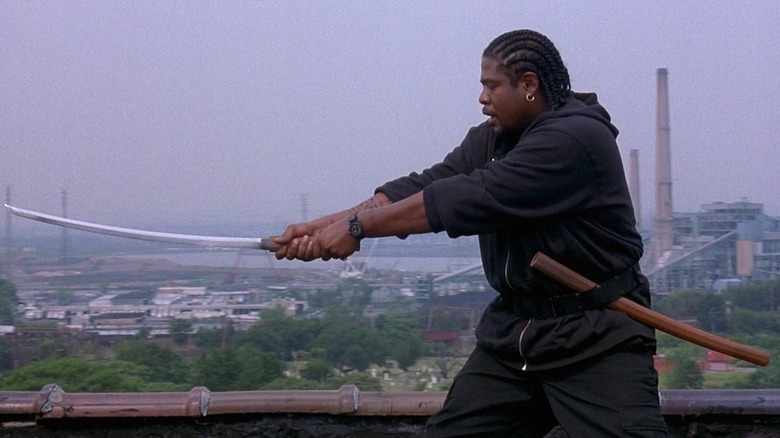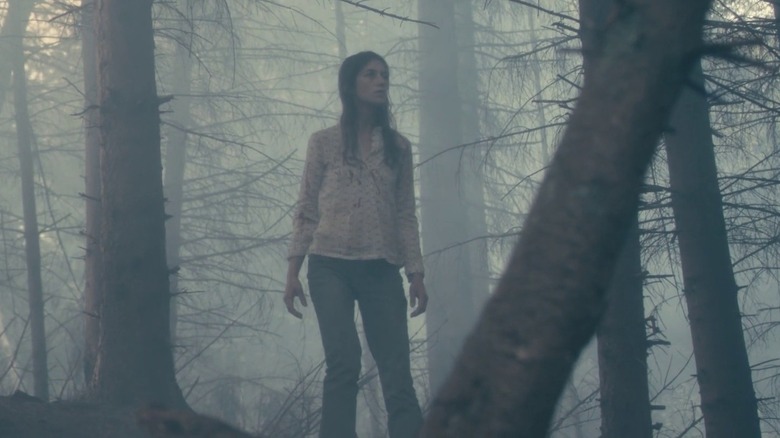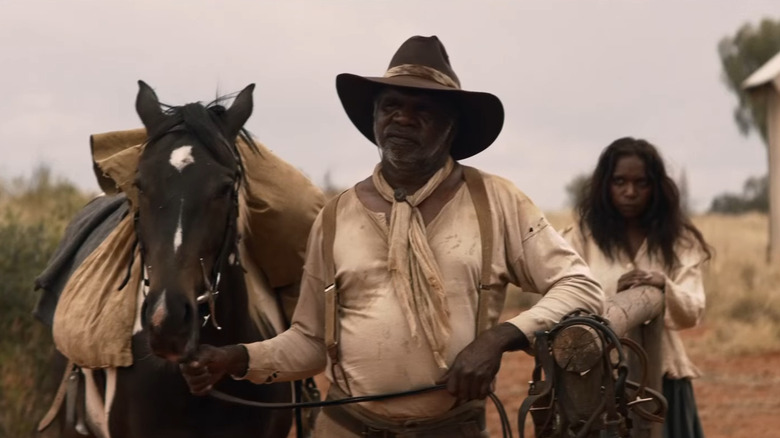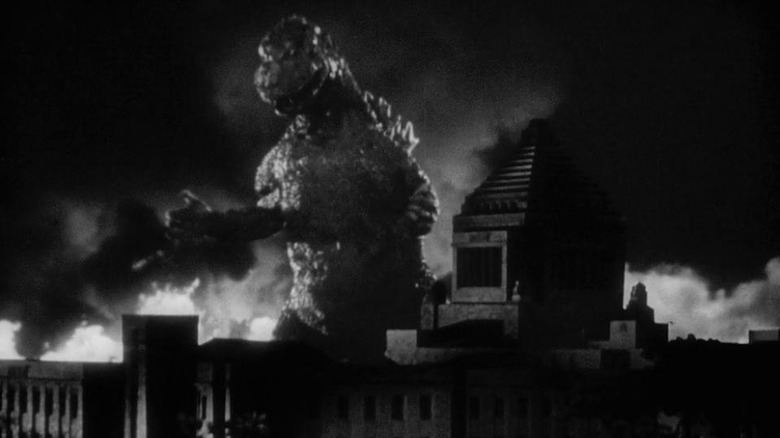20 Best Genre Movies On The Criterion Channel
The Criterion Channel — streaming home of (most of) the Criterion Collection and a number of other curated features and shorts — is often considered the place to look for highfalutin, subdued dramas. While there are undoubtedly a lot of movies on the service that meet that criteria, the Criterion Channel shouldn't be pigeonholed as simply a place for high-minded and subtle movies. It's also home to a wide variety of genre movies from across the world and the 20th and 21st century.
There are movies on the service that range the genre gamut from science fiction to neo-noir, from Westerns to horror. Perhaps most surprisingly, there's also a good amount of action. And these films really do come from all across the world and the last hundred years of cinema. So whether you're looking to get scared, pumped up, or lost in a criminal underworld or the Old West, there's a genre movie for you on the Criterion Channel.
Police Story
"Police Story" is perhaps Jackie Chan's greatest movie, both as a director and an actor. "Police Story" follows Chan Ka-Kui (Chan) as he's tasked with protecting a witness for the prosecution of drug lord Chu Tao (Chor Yuen). But she's not just any witness — she's the criminal's young, attractive secretary Salina (Brigitte Lin), which causes problems for Ka-Kui with his girlfriend (Maggie Cheung) when she thinks Ka-Kui is flirting and spending time with another girl.
And that's just the first half of the movie. Well, that and a number of over the top, truly jaw-dropping action-comedy sequences. That includes the destruction of an entire shantytown by a car chase that goes straight through it, as well as one of the most acrobatic scenes in Chan's career when he gives chase to a moving bus on foot.
The second half of the movie becomes somewhat more serious as Ka-Kui is framed for murder by Chu Tao, but it never loses its light tone. In fact, the lengths to which Ka-Kui goes to clear his name are downright ridiculous and simply couldn't be played seriously. As a result, "Police Story" is one of the greatest action-comedies ever made, and it's also one of the purest expressions of a director's style and vision ever put to film. It shouldn't be any surprise then that the Criterion Channel would want to celebrate this piece of pure auteur cinema, even if that auteur's style includes stunts that land him in the hospital.
Lady Snowblood
Meiko Kaji is an icon of Japanese genre film. In the 1970s, she starred in four different franchises ("Stray Cat Rock," "Female Prisoner Scorpion," "Wandering Ginza Butterfly," and "Lady Snowblood"), each of which have become cult classics. More than that, she also had a thriving career as a singer and sang the theme songs for many of the films she starred in.
All that to say, she's a big deal, and "Lady Snowblood" may well be the best movie that she starred in. "Lady Snowblood" became an even bigger deal in the 2000s when Quentin Tarantino cited it as one of the major inspirations for "Kill Bill" movies.
The film follows Yuki, who's born into a prison and immediately handed a mission of revenge from her mom. Yuki is to become a skilled assassin and then use her skills to track down and kill the group of men who murdered her father and assaulted her mother.
The standard revenge plot gets a bit more morally and narratively complicated as the movie goes on. But the real reason to seek out the film is Kaji's steely performance and the stunning style of the movie. The entire film is gorgeously shot, but the action scenes in particular offer some of the most breathtaking images ever set to screen. Blood spray has never been more beautiful than it is in "Lady Snowblood."
Sword of Doom
There are a lot of samurai movies on the Criterion Channel, ranging from the films of Akira Kurosawa to the long running series of "Zatoichi" and "Lone Wolf and Cub." But none of them are quite like "Sword of Doom," which centers on master swordsman and certified sociopath Ryunosuke Tsukue (Tatsuya Nakadai).
"Sword of Doom" plays like a horror movie centered on the villain. It's kind of like "American Psycho," except instead of an insecure businessman in the 1980s, we're focused on a skilled swordfighter who believes he's the best in the world. He uses his skills to kill without repercussions and take advantage of other swordsmen who fear his abilities.
Beyond the human evil of Ryunosuke, "Sword of Doom" also includes some hints of the supernatural that give the movie a sense of otherworldly evil. At one point, Ryunosuke is told that a brothel room is haunted, and he begins seeing ghosts that may or may not be real. Another swordsman also speaks of a connection between swords and the souls of their owners, stating, "Evil mind, evil sword," which haunts Ryunosuke.
But not only is "Sword of Doom" a horrifying movie about a remorseless killer, it's also an incredibly exciting action movie, especially in its latter half as Ryunosuke's arrogance and evil deeds begin to catch up with him. The film's finale, which shows him facing off with seemingly innumerable enemies, is one of the most exciting action sequences in samurai cinema.
Blood Simple
Joel and Ethan Coen burst onto the independent movie scene with the brutal "Blood Simple." This neo-noir tells the story of bartender Ray (John Getz), who's having an affair with Abby (Frances McDormand), his boss's wife. However, bar-owning cuckold Marty (Den Hedaya) has been growing suspicious of something amiss and hires private detective Loren Visser (M. Emmet Walsh), who's quick to find Ray and Abby in a state of undress and deliver pictures to Marty. But that's just the start.
Marty then hires Visser to kill Ray and Abby, setting off a chain reaction that leads to some truly suspenseful and even horrifying sequences. "Blood Simple" is often celebrated for the way that it combines horror filmmaking with a crime story, and there's one scene in particular that goes on for an almost painful amount of time with no dialogue, and it's one of the most disturbing death scenes in cinema history.
The movie also makes great use of dramatic irony throughout, lending the movie's fatalism an even more hopeless feeling but also highlighting that the Coens had a wry side from the start as it's impossible not to laugh at some of the assumptions characters make. Fun fact — "Blood Simple" was the feature film debut of Frances McDormand who later went on to win an Oscar for her role in the Coens' "Fargo" and get married to Joel.
Ghost Dog: Way of the Samurai
In the 1990s, indie movie royalty Jim Jarmusch decided that he wanted to start taking on genre movies and giving them his own unique twist. He began with "Dead Man," a black-and-white Western that almost doubles as a hangout movie, and followed it up with the idiosyncratic and wonderful "Ghost Dog: The Way of the Samurai."
The movie follows the titular Ghost Dog (Forest Whitaker), who works as a hitman for Louie (John Tormey). But Ghost Dog isn't just any hitman — he lives by the tenets set out in the "Hagakure," a guide for honorable warriors originally written in the early 18th century. The focus and dedication that Ghost Dog brings to his craft as a warrior make him a formidable opponent when the mob turns on him. But the movie also makes space for quieter moments in Ghost Dog's life, like his incredibly sweet friendship with ice cream man Raymond (Isaach de Bankolé), who can only speak French, making it impossible for him and Ghost Dog to communicate with language.
The movie also features a fantastic score that adds yet another culture into the film's melting pot of Italian mafia and Japanese codes of honor. It's the first film score from the Wu-Tang Clan's RZA, and he brings a combination of catchy, hard-hitting, and smooth boom-bap hip-hop beats to film.
Double Indemnity
"Double Indemnity" is quintessential noir. It's got the voice-over from a protagonist who narrates the story shown in flashback, it's full of beautifully lit shots that highlight the interplay of light and shadow, and of course, there's the dangerous femme fatale. The movie, based on the book of the same name by James M. Cain, follows insurance salesman Walter Neff (Fred MacMurray) as he meets the alluring Phyllis Dietrichson (Barbara Stanwyck) and becomes involved in a scheme to kill her husband.
Neff and Phyllis plan to get her husband on a significant payout accident insurance plan, without his knowledge, so they'll get a big payout when he dies. Neff believes his knowledge of the insurance business will allow him and Phyllis to get away not only with the murder but also with collecting on the policy. Of course, things aren't so easy as they have to first commit murder and then fool claims adjustor Barton Keyes (Edward G. Robinson), who's got a nose for sniffing out fraud. And as Keyes closes in on the truth, Neff begins to suspect that he can't entirely trust Phyllis, leading to a confrontation that's the stuff of noir legend.
Vampyr
Directed by Carl Theodor Dreyer — a highly influential director best known for his 1928 masterpiece "The Passion of Joan of Arc" — "Vampyr" is a horror movie where the chills come almost entirely from its atmosphere. But it's such a specifically otherworldly and unnerving atmosphere that it still leaves you feeling frightened well after the credits roll.
The story follows student of the occult Allan Gray (Nicolas de Gunzburg), who arrives in a town in the French countryside where strange things soon begin to happen. On his first night at a local inn, a man comes into his room and leaves him a letter with "to be opened upon my death" written on it, and shortly thereafter, the man is killed. The letter reveals that the town is cursed by a vampire, and Gray, along with some of the townsfolk, sets out to break the curse.
But along the way, the film offers a number of sequences that blur the line between reality, illusions, and visions of the future. Dreyer shoots the entire movie with a soft focus that lulls the audience into a strange dreamlike state, and the lack of dialogue makes the film's world feel removed from our own.
Kuroneko
Fans of Japanese horror are well-familiar with Kaneto Shindo's horror classic "Onibaba," but where that movie merely gestures at the supernatural, his "Kuroneko" is a full-on ghost story.
After Yone (Nobuko Otowa) and her daughter-in-law Shige (Kiwako Taichi) are killed and their home is burned down by a group of wandering samurai, a black cat appears and licks their corpses, returning them to life as ghosts who can create illusions for the living. They use their newfound powers to take revenge on the samurai in a sequence that's equally beautiful and disturbing.
Things become more complicated when samurai Hachi (Kichiemon Nakamura) returns from war to find his mother and wife missing and his home burned to the ground. A conflict arises for the ghosts as they have sworn to kill samurai in revenge for their deaths, but with the return of their beloved son and husband, they suddenly don't wish to indiscriminately kill all samurai.
The movie takes some twists and turns and is gorgeously shot in black and white, creating a spooky, otherworldly atmosphere that's almost as enchanting as it is frightening.
Antichrist
"Antichrist" follows characters known only as She (Charlotte Gainsbourg) and He (Willem Dafoe), who — after the death of their young son — retreat to a cabin called "Eden" in the woods. It sounds like it could become a powerful two-hander drama or something like "The Evil Dead," but instead, it becomes something much more interesting and unique.
As the film goes on, we see He, a therapist, attempt to treat his wife's grief clinically, but this doesn't help her and seems to only cause more problems for their relationship. But there's more going on in the woods than just their grief. He begins to have visions of animals that seem at minimum like bad omens and at most like outright threats. And yet the threats never come from the outside. Instead, the possibly supernatural and the all-too-real relationship between He and She explode together in a finale that's unlike anything else.
The movie is a beautiful combination of extreme and arthouse horror as it takes its time to develop a sense of inescapable dread and dives into the psychology of grief, but it also delivers on some of the most extreme violence you can find in any film — especially on the Criterion Channel.
Night of the Living Dead
George A. Romero's "Night of the Living Dead" essentially birthed the zombie genre as we know it today, even though no one says the word "zombie" in the entire movie.
The film centers on a group of people who find themselves holed up in a home in the Pennsylvania countryside as reanimated corpses attempt to break in. However, as with many zombie movies since, "Night of the Living Dead" uses the zombies as a launching pad to explore human relationships in times of crisis. And it's the conflicts between the people in the house — over what the best course of action is and who should be considered the leader — that lend the movie its palpable tension from early on. But don't be fooled, there's still plenty of shocking zombie horror, including gore that's surprising to see in a movie from 1968.
"Night of the Living Dead" is also a major moment in the history of Black characters in film, as it's one of the first horror movies to have a Black man as the protagonist. Not only is Duane Jones' Ben one of the most charismatic people in the house, but as the movie goes on, it becomes clear that he's perhaps the only one competent enough to survive and help others survive.
Scanners
David Cronenberg, the king of body horror, has made a number of thought-provoking and stomach-churning science fiction horror movies, and "Scanners" is among the best. The movie follows vagrant Cameron Vale (Stephen Lack), who's recruited by the ConSec corporation for his special abilities. ConSec informs Vale that he's a "scanner," a select group of people who have a variety of telepathic and telekinetic abilities, and tasks him with hunting down rogue scanner Darryl Revok (Michael Ironside).
The first scene we see with Revok is the stuff of horror movie legend as he and one of ConSec's scanners get into a mental battle that ends with the ConSec scanner's head exploding in a glorious pop of practical effects blood and brain matter. It's somewhat surprising then that most of the movie isn't actually that heavy on Cronenberg's signature body horror and instead plays out almost like a political thriller, with Vale and fellow anti-Revok scanner Kim Obrist (Jennifer O'Neill) investigating the villain and the genesis of scanners.
As a political thriller, "Scanners" is disturbing for the social commentary. But in its finale, it once again offers one of the goopiest and most difficult-to-watch body horror sequences in Cronenberg's filmography, as scanners have a mental battle that begins to take a toll on their bodies, resulting in a movie that's both wonderfully disgusting and a social statement.
The Third Man
While Orson Welles remains most famous for starring in and directing "Citizen Kane," it's far from the only great movie in his acting career. One of his other great roles is in "The Third Man," where he plays the mysterious Harry Lime. Harry was supposed to meet his friend Holly Martins (Joseph Cotten) in Vienna and put Holly onto a job, but when Holly arrives, he's told that Harry is dead.
Holly grows suspicious of the stories that he's told about Harry's auto accident death, as accounts differ on whether two or three men dragged Harry's body from the wreck. But as he and Harry's girlfriend (Alida Valli) investigate together, they learn that Harry may not have been the morally upright person they thought, and as they learn more about him, more questions arise about his death.
It's a captivating mystery that's beautifully brought to life by director Carol Reed with incredible classic noir lighting and great performances from the entire cast, especially Welles. The film also features chase sequences through the sewers of Vienna that are so iconic that you can still go on a tour of the underground locations today.
Welcome II the Terrordome
Ngozi Onwurah's 1994 science fiction masterpiece "Welcome II the Terrordome" remains hugely underseen to this day, but hopefully its inclusion on the Criterion Channel can change that.
The film centers on Anjela (Suzette Llewellyn), her brother Spike (Valentine Nonyela), and his pregnant girlfriend Jodie (Saffron Burrows) who all live in the dystopian, almost entirely Black ghetto known as "the Terrordome." Anjela and Spike are Black and have lived in the Terrordome their whole lives, but Jodie is white and has retreated to the Terrordome in an attempt to escape an abusive white ex. That ex, who's also explicitly racist, attempts to take revenge on Spike and Jodie, but things don't go as planned, leading existing racial and political tensions to explode.
"Welcome II the Terrordome" is a gorgeously directed and performed movie that's incredibly emotionally impactful, if also often difficult to watch. That emotional core also makes the movie's righteous anger — that sadly feels just as relevant today as it did when the film was originally released in 1994 — all the more infectious. It's a movie that seeks to provoke its audience in a political way, but it doesn't ever feel preachy and is absolutely thrilling from start to finish.
Marlina the Murderer in Four Acts
"Marlina the Murderer in Four Acts" has the distinction of being the only Indonesian spaghetti Western, and to top it off, it's one of the few movies in the Western genre directed by a woman.
The movie centers on the titular Marlina (Marsha Timothy), whose home is attacked by a group of bandits at the start of the movie. However, after experiencing true horror, she manages to poison most of the bandits and decapitate their leader. But she wants to make sure that things are all correct legally so she collects the severed head and heads to the nearest police station to make a report. Along the way, she meets the pregnant Novi (Dea Panendra), who's searching for her husband and becomes a key player in the remaining bandits' plans to avenge their leader.
The movie is visually stunning as writer/director Mouly Surya uses ultra widescreen to highlight the beauty of the desert landscapes and breathtakingly blue skies. And as with any spaghetti Western, the music is phenomenal. Composers Zeke Khaseli and Yudhi Arfani deliver a score heavy on horns that could've been plucked from one of the great spaghetti Westerns of the 1960s. But what makes "Marlina the Murderer in Four Acts" so special is it's focus on Marlina and Novi and the way these women survive in a cruel and unforgiving world dominated by violent men.
The Steel Helmet
"The Steel Helmet" follows Corporal Zack (Gene Evans), the lone survivor of his unit after they're executed by North Koreans during the Korean War. But Zack doesn't remain alone for long, as he escapes and teams up with a South Korean boy nicknamed Short Round (William Chun) and Black infantry medic Corporal Thompson (James Edwards), all before encountering a larger group of American soldiers.
Not long after, the film's first battle begins. Interestingly, while these sequences are tense, they aren't fun. These are small-scale skirmishes where it's difficult to see through the dense jungle, but most of all, we're more afraid for our heroes than we are rooting for them. But as the movie goes on, the group retreats to a Buddhist temple where they find an enemy major. From here, the movie turns into a siege film, like "Assault on Precinct 13," as the Americans and their prisoner attempt to survive the attacks on the temple.
What makes "The Steel Helmet" one of the best genre movies is its attention to the social issues that inform its characters' actions. Several of the white GIs are racist towards Thompson, and the North Korean major attempts to convince him and the Japanese-American Sergeant Tanaka (Richard Loo) that they shouldn't be loyal to a country prejudiced against them. It's surprising stuff from a war movie made in 1950, but it adds another layer of depth to a movie that's already committed to entirely de-romanticizing war.
Walker
Alex Cox is known as the punk director behind "Repo Man" and "Sid & Nancy" and working with Joe Strummer of The Clash on "Straight to Hell." But we don't think enough credit goes to his absolutely punk Western "Walker," which is also scored by Strummer.
The film tells the true story of the titular William Walker (Ed Harris), a soldier of fortune who in the early 1850s went to Nicaragua with a group of mercenaries to incite a revolution. Walker was funded by American millionaire Cornelius Vanderbilt, who sought to secure land rights that the existing government would not grant him.
But when Walker successfully overthrows the government, he grows more and more arrogant, eventually naming himself president of the country and rejecting Vanderbilt's claims on the land. Unsurprisingly, things don't go well for William Walker as the people of Nicaragua and their neighboring countries have no desire to be ruled by a white despot.
While "Walker" focuses on the titular character, the movie never sympathizes with him and instead offers a portrait of a man driven mad by power. But more than that, the movie draws significant parallels between Walker's tale and the then-current violence created by U.S.-funded Contras in Nicaragua. "Walker" is a powerful anti-colonialist movie that's just as interested in provoking a reaction from its audience as it is in thrilling them with its Western shoot-outs.
Sweet Country
An anti-colonialist Western based on historical events, "Sweet Country" takes place in early 20th-century Australia, centering on the violence done to Aboriginal people by English settlers.
The movie follows Aboriginal farmhand Sam Kelly (Hamilton Morris), who goes on the run after killing a white man in self-defense because he knows that colonial justice will not favor him. Despite its name, "Sweet Country" is a brutal movie. It shows the violence, including sexual violence, that white colonizers enacted on Aboriginal people in Australia and the ways in which the colonial system was organized to allow whites to do so with impunity.
However, "Sweet Country" is a thrilling Western that largely follows a standard chase narrative, following Sam and his wife (Natassia Gorey-Furber), as well as their pursuers led by the racist Sergeant Fletcher (Bryan Brown). But its central premise of a man being hunted for defending himself is devastating. And the performances from Morris and Gorey-Furber bring that pain to life in a way that makes it impossible to look away from.
"Sweet Country" was nominated for many awards at the 2018 Australian Academy of Cinema and Television Arts Awards and won most of them, including best actor for Morris, best direction, best screenplay, and best film.
Man of the West
There are several movies that mix the Western and film noir genres, but the best among them comes from a master of both style, Anthony Mann. Mann directed more than 10 Westerns and noir films, and in "Man of the West," he brings his excellence in both genres together.
The film follows Link Jones (Gary Cooper), an ex-outlaw who's gone straight and is on the road searching for a schoolteacher for his new hometown. But, of course, things aren't so simple, as the train he's on is stopped at a station and attacked by his old gang, who want him to rejoin them.
"Man of the West" then takes place overwhelmingly in a small farmhouse where Link, his old gang mates, and two innocent bystanders who've been pulled into the situation are holed up after the robbery. Link now must convince his former friends that he's still a criminal capable of great violence so that he can save not just himself but also the others who've been captured.
The small scale of the film allows Mann to ratchet up the tension until the farmhouse feels like a powder keg ready to go off at any moment with the slightest misstep from Link. It's also shockingly brutal for a movie from the 1950s and is perhaps one of the most hard-boiled noir films. The end result is a thrilling film that film critic Philip French calls "Mann's masterpiece."
Le Samouraï
Directed by Jean-Pierre Melville, "Le Samouraï" tells the story of a hitman who finds himself hunted. Jef Costello (Alain Delon) is a professional — an assassin who always ensures that he has airtight alibis before killing his targets. But one evening after he kills a nightclub owner, he's spotted by several witnesses.
Jef becomes the prime suspect for the police, but one of the witnesses says that she never saw him at the club, provoking questions and creating a mystery. Jef attempts to make sense of why this woman, Valérie (Caty Rosier), would lie for him. But it's not the mystery that makes "Le Samouraï" one of the best genre movies on the Criterion Channel. Instead, it's Alain Delon's laid-back, almost emotionless performance and Jean-Pierre Melville's mastery of mood.
This neo-noir thriller is surprisingly atmospheric and doesn't include much dialogue, instead allowing the images to speak for themselves. The best of the long dialogue-free stretches are when the audience is shown Jef's routines, highlighting the care with which he proceeds in almost every endeavor, as well as a thrilling chase scene through the metro. "Le Samouraï" is simply one of the coolest movies ever made, and you can feel its fingerprints all over movies like Nicolas Winding Refn's "Drive."
Godzilla
"Godzilla" is rightfully one of the most iconic movies ever made, launching a massive franchise and creating an entire subgenre of creature features. But what's most surprising is how human "Godzilla" is. The movie certainly gives its titular monster a lot of time to shine and offers some of the most breathtaking scenes of kaiju destruction ever put to film, but at its heart, "Godzilla" is a movie about humans and human issues.
The story broadly centers on Godzilla's attacks and society's response to the attacks, but within that, there's a significant amount of time spent on melodrama. While her father Kyohei Yamane (Takashi Shimura) leads an investigation into Godzilla, Emiko (Momoko Kōchi) is stuck in a love triangle. She is in love with ship captain Hideto Ogata (Akira Takarada) despite her engagement to her father's fellow scientist Daisuke Serizawa (Akihiko Hirata). And while Godzilla is a clear symbolic stand-in for the nuclear bombs used to attack Japan during World War II, the film goes to great lengths to discuss the hubris and dangers associated with a weapon they may use against the giant monster.
Instead of letting its message about humanity's capabilities for violence remain subtext, the movie makes it very clear through multiple conversations. As a result, "Godzilla" remains one of best kaiju movies ever made, and while the sequences of Godzilla's destruction are perhaps most visually memorable, its concerns about humanity's relationship with science and violence are what really stick with you.



